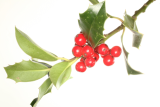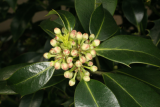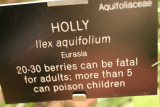Additional notes (click to expand)
Medicinal
There are several references to its use in the treatment of chilblains (traditional medicine). Patients would be whipped with a sprig of holly, and as they bled, it was believed their circulation would improve. A less painful treatment for chilblains involved mixing powdered holly berries with lard and applying directly to the skin. In Hampshire, it was believed that milk drunk from a bowl carved from the wood of a variegated holly would cure a child of whooping cough.
Allen, David E., Hatfield, Gabrielle. (2004). Medicinal Plants in Folk Tradition. Timber Press p168
Geographical distribution
- Africa, Northern Africa, Algeria
- Africa, Northern Africa, Morocco
- Africa, Northern Africa, Tunisia
- Asia-Temperate, Western Asia, Iran
- Asia-Temperate, Western Asia, Lebanon-Syria
- Asia-Temperate, Western Asia, Turkey
- Europe, Northern Europe, Great Britain
- Europe, Southeastern Europe, Albania
- Europe, Southeastern Europe, Bulgaria
- Europe, Southeastern Europe, Italy
- Europe, Southeastern Europe, Yugoslavia
- Europe, Southwestern Europe, France
- Europe, Southwestern Europe, Portugal
- Europe, Southwestern Europe, Spain
Ilex aquifolium L.
Family: AQUIFOLIACEAEGenus: Ilex
Species: aquifolium L.
Common names: Common Holly
Distribution summary: Eurasia
Habit: Shrub
Hardiness: H5 - Hardy; cold winter
Habitat: Deciduous forests, damp, shady spots
Garden status: Not currently grown
Reason for growing: Medicinal, toxic



.JPG)
.JPG)